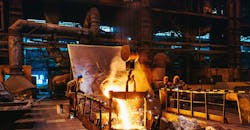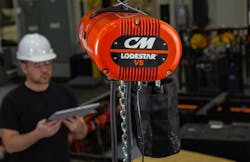Modernizing Rigging and Lifting in Ferrous Foundries
In the world of iron and steel foundries, failure is not just expensive—it’s dangerous. Whether it’s a 2,800°F ladle of molten iron, a 4,000-lb mold being repositioned mid-shift, or a crane moving a critical casting to the cooling bay, every lift matters. The pace is relentless, the environment is punishing, and one wrong move can halt production—or worse, cost lives.
Foundry work has always demanded grit, precision, and strong backs. But in 2025, that’s no longer enough. As injury rates across the sector remain among the highest in US manufacturing, safety managers and plant leaders are under pressure to modernize their approach to material handling. The stakes? Reduced injuries, more up-time, and ultimately, a safer and more productive facility.
That transformation starts with the fundamentals: rigging practices, equipment suitability, and how well teams adapt to—and adopt—modern tools like predictive maintenance, remote monitoring, and automated load control. Smart upgrades to lifting and rigging workflows do not just reduce accidents—they boost efficiency in ways that ripple across every shift.
The brutal reality
If you’ve never set foot on a melt deck or tried to rig a load under a crane beam covered in six months’ worth of soot, it’s easy to underestimate just how hostile the foundry environment can be. Temperatures on the shop floor routinely exceed 120°F, and near the furnaces, ambient conditions can surge past 160°F. Add to that suspended particulates, hot slag spatter, low visibility, and a constant accretion of abrasive dust that coats every piece of equipment from pendant controls to sling shackles.
This is not a controlled environment - and that matters. Standard lifting gear degrades faster here. Motors overheat. Chains wear. Remote controls jam from silica intrusion. Even the best-maintained set-ups require rigorous daily inspections. For operators and riggers, the risks are not theoretical. One failed hoist or sling snap under a full ladle and you’re looking at catastrophic damage and potential fatality.
Space constraints further complicate things. Between casting lines, furnaces, cooling beds, and finishing zones, operators often work in tight quarters—forcing awkward lifts and increasing the risk of side loading or uncontrolled sway. The reality is: many foundries are still relying on outdated manual hoists, fatigued slings, or poorly matched lifting hardware simply because it “still works.”
But in a foundry, “still working” is not good enough. Safety managers know it. Operators live it. The challenge is to find lifting systems - and rigging protocols - that can stand up to the workplace environment without introducing new complexity or downtime.
Rigging best practices
In foundries, rigging is not a secondary task - it’s central to the operation. Every casting, mold box, or ladle must be rigged and lifted with absolute certainty. And yet, it’s common to see examples where foundries have taken shortcuts: wrong hook, worn sling, no load weight calculation, or worse - someone standing under the lift.
That’s how accidents happen. And in a foundry, accidents do not just bruise egos: often, they lead to injury or death.
These are the non-negotiable standards for rigging in steel and iron foundries:
- Rigging must be done by trained personnel: Only qualified and trained riggers should handle the lift plan, choose slings and hardware, and attach loads.
- Use the right hardware for the environment: Alloy chain slings (Grade 80 or 100) handle the temperature swings. Self-locking hooks prevent disengagement. Corner protection matters.
- Inspect. Every time: Check for wear, cracks, stretching, weld integrity, or contamination. If in doubt - pull it out.
- Know your load and your path: Weight, center of gravity, lift points, load path - check them all before the hook goes live.
- Do not rush. Ever: No pour is worth a shortcut. Plan, communicate, and lift with eyes on the work.
- Use rigging as a culture marker: Create a safety-first rigging environment - where damaged gear is binned, not debated.
Upgrading equipment for safety and efficiency
Rigging best practices only go so far when your equipment is working against you. In too many foundries across the U.S., operators are still relying on outdated manual chain falls or hoists designed for lighter-duty environments. The result is slower cycles, higher physical strain, and increased risk of failure in critical lifts.
Modernizing lifting gear is not about chasing shiny new tech. It means matching the equipment to the brutality of the environment and the demands of the operation.
Upgrading to a high-quality electric chain hoist is not just about reducing manual labor. It means establishing consistent, controlled lifting in a harsh and unpredictable setting.
Many foundries are transitioning to electric chain hoists built for demanding applications - especially in high-duty cycle operations where uptime and safety are non-negotiable.
If your team is still relying on manual chain falls - which requiring significant operator effort, constant supervision, and often inconsistent lift control - you’re working with outdated tools in an unforgiving environment. These systems slow down production, increase physical strain, and leave more room for human error.
Even switching from a generic off-the-shelf hoist to a ruggedized, industrial-rated version can reduce inspection issues, minimize wear and tear, and speed up lift cycles by 30–50%.
Smarter lifting starts with better data
You do not need robots on the melt deck to benefit from automation. In modern foundries, smart tech is not replacing humans but is supplying the best available information to enhance what already works.
Predictive Maintenance is no longer optional because in a metalcasting operation, downtime is expensive. A failed hoist during a critical lift can shut down a line or delay a pour. Smart hoists now monitor runtime hours, temperature spikes, and overload events, sending alerts before breakdowns occur.
A real-world example
The CM Lodestar VS paired with Intelli-Connect gives maintenance teams wireless access to real-time data from the hoist - right from a mobile device or dashboard. It will track motor performance, monitor overload history, and identify excess runtime while logging thermal data to spot overheating.
For foundries, it’s a proactive way to avoid hoist failure and keep up-time high.
In metalcasting operations, automation reduces risk, including anti-sway and auto-centering cranes; remote control technology and camera positioning; smart load monitoring and weight distribution sensors; and semi-autonomous lifting paths. These systems are not replacement workers. They are back-up operators in critical functions.
Safety and efficiency payoffs
Modernizing material handling is not a luxury. It is a necessary investment for enhancing performance in metalcasting operations. For example, self-locking hooks and rigging discipline reduce incidents – and safer workers will result in higher retention.
Predictive maintenance cuts breakdowns. Fix what is failing before it fails. With reduced downtime, metalcasters gain more pouring time.
Automation trims seconds off the time of every lift, which over multiple work shifts adds up to a lot of additional productivity. Today, the best-performing foundries are not just pouring more - they’re lifting strategically.
Foundry floors are not getting any cooler or easier, but your approach to material handling can. Start with the systems in place to lift your loads. Introduce technology where it makes sense. Enforce rigging discipline. Give your team the tools to lift better, safer, and faster.
The technology is here. The practices are proven. The time to modernize is now.

